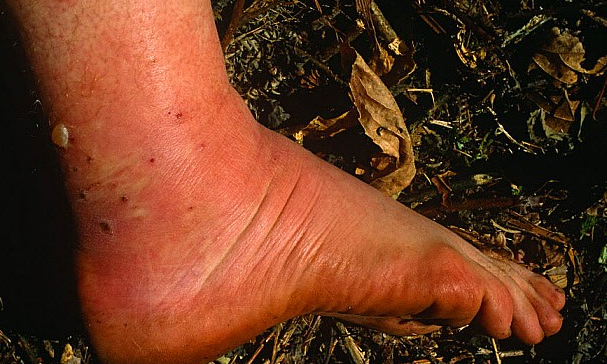
During a holiday in regional NSW, a middle-aged woman develops an unusual skin condition characterised by two crusted papules on her right foot.
She discovers the lesions an hour after walking around bushland. At the time, she also notices blood on her shoe.
The lesions have now been present for a week. They are associated with persistent itching and are exacerbated by touch or exposure to hot water.
The patient seeks medical advice to identify the cause and potential risks associated with these lesions, considering the peculiar circumstances and geographical location in which they developed.
What is the most likely diagnosis?
Correct!
The unnoticed attachment and subsequent persistent itching align with the characteristics of leech bites. In this case, the presence of two bites may be attributed to the characteristics of leech blood-feeding behaviour.
Leeches — known as sangsue in French, meaning ‘blood suckers’ — typically have three jaws and create multiple incisions as they move during feeding. Therefore, bites from a single leech may appear as distinct lesions because of leech movement or reattachment.
Leech bites are painless as leeches secrete anaesthetic substances during attachment. In this instance, the patient’s initial lack of awareness and subsequent discovery of blood on her shoe align with the typical features of leech bites.
The patient later recalled someone in a restaurant, where she had stopped for lunch, commenting that they had found an engorged leech on the floor, which may have dropped off after feeding.
The persistent itching experienced by the patient is consistent with the inflammatory response triggered by substances present in leech saliva.
Leech bites have been reported to transmit bloodborne viruses — including hepatitis B and HIV — in endemic areas of high prevalence, such as Africa. If bites occur in a region of high prevalence, serological testing may be indicated. Otherwise, management is symptomatic only.
A topical steroid may aid with itch, and a topical antibiotic can be applied if there are features of infection. The reaction may take a week to subside.
Cutaneous leishmaniasis often presents as crusted or ulcerated papules from the bite of a sandfly. The lesions usually appear weeks or months after the bite.
Typically, cutaneous leishmaniasis is found in more tropical and subtropical regions. In Australia, leishmaniasis has only been reported in patients who have acquired it overseas.
Spider bites can result in localised skin reactions, often associated with pain, redness and swelling. The absence of significant pain and the persistent itching make a spider bite less likely.
Insect bites can cause localised erythema, itching and discomfort. However, the patient’s delayed awareness of the lesions is less typical. Persistent pruritus also deviates from the usual symptoms associated with insect bites.
